Elite Swim Camp
Somax has developed a special five-week camp to prepare young swimmers for international competition. Our Elite Swim Camps will be available in 2019. These five-week Elite Camps are designed for young swimmers who are not already on a national team. For national team swimmers, please see our National Team Program or our Level V Individual Program.
Each participant in our Elite Camps under the age of 18 must be accompanied by a parent who will learn our system of underwater videotaping and analysis.
We guarantee that participants in our Elite Swim Camp will swim faster within one year of finishing their camp, or their camp will be free*.
Camp Schedule
The five-week camp will consist of five five-day weeks, Monday-Friday.
Each day will consist of three hours of in-pool stroke drills and underwater videotaping or dryland analysis and training each morning. In the afternoons, each swimmer will receive one session per week of Microfiber Reduction. Those swimmers not receiving their Microfiber Reduction session will be able to practice their Somax drills in the pool for two hours.
Camp Instruction
Somax trains swimmers to improve their stroke efficiency by frame-by-frame underwater stroke analysis coupled with its exclusive drills and training aids and improves flexibility in swimmers 50-300% beyond what they can get from stretching alone.
This unusual program grew out of 1500 hours of research Somax conducted during 1985-7 on underwater tapes of World Record swimmers, as well as measuring many Olympic swimmers and training 17 elite swimmers over the past 22 years.
Many of our findings were at variance with wide-spread assumptions about swimmers and swimming. One World-Record holder, for instance, while holding the five fastest times in the world in the 100m freestyle, had 10% less power output in his arms (as measured on a bio-kinetic bench), but 70% more power in his hips than other sprinters on his team. He also had a total of 70 degrees more range of motion in his shoulders. These findings tell us that flexibility in the shoulders is more important than strength in the arm, and that the power in swimming comes from the hips--and not from the muscles of the arms.
Janet Evans' breathing ranges were at least 50% greater than her competitor's breathing ranges, while her VO2max was only 56, compared to her competitors with a VO2max of 70-80. At the time, Janet held world records in the 400, 800 and 1500m freestyle. These findings tell us that flexibility in the chest and abdomen are more important than fitness for winning swim events.
The 17 elite swimmers Somax has trained went on to earn 43 Gold Medals and set 11 World Records in international competition after their Somax training. Independent analysis of these swimmers (hand force output curves, reduction in stroke count, and speed trials) confirmed the improvements in each of these swimmers.
Elite Somax Swimmers
Amy Van Dyken
Somax trained Amy Van Dyken at a week-long camp at Colorado Springs during the end of August 1995, at the request of her coach. Amy doubled her peak force output, and while she did not increase her stroke length at race pace, she was able to drop her stroke count while training from 30 to 15 on 50m.
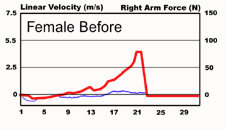 |
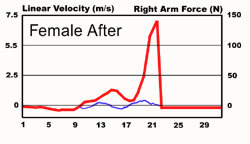 |
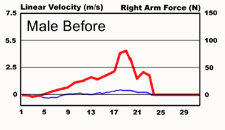 |
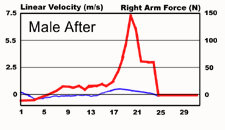 |
These graphs show that swimmers who increased the acceleration of their hips doubled the peak hand force (heavy solid line) they applied to the water after just one week of Somax training. You can see that neither swimmer produced much force until after they rotated their hips. The female sprinter was able to advance the timing of her hip rotation (thin, broken line) and thus doubled her insweep peak. The male sprinter delayed his hip rotation, and his initial hand force output was less. Then he doubled his peak force as he accelerated his hips. The female sprinter, Amy Van Dyken, won four Gold Medals and the male sprinter, Jon Olson, won two Gold Medals at Atlanta.
Amy dropped her time in the 50m free from 25.03 to 24.87 (.6% drop) and in the 100m free from 55.76 to 53.91 (relay) (3.3% drop). She won four Gold Medals at Atlanta.
Amy increased her AIR and hip extension ranges from 40 to 60 degrees with two sessions of Microfiber Reduction. She was able to swim free of shoulder pain after her Somax camp.
Unfortunately, Amy injured her shoulder lifting weights after the Olympics, and had to recuperate for a year after shoulder surgery. She re-entered competition and won two Gold Medals at Sydney.
BEFORE |
AFTER |
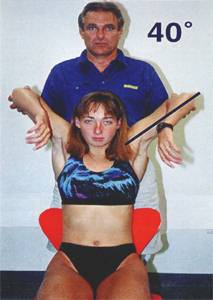 |
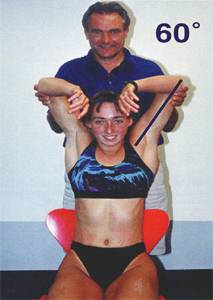 |
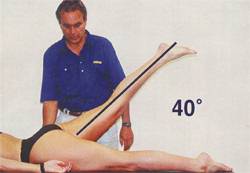 |
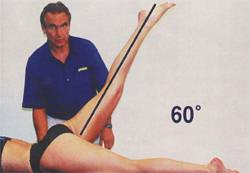 |
These photos show the improvement in shoulder and hip flexibility in Amy van Dyken from just two hours of Microfiber Reduction. The shoulder range AIR (Abduction with Internal Rotation) is critical for keeping the elbows up during the stroke. Hip extension is critical for reducing drag.
Jon Olson
Somax trained Jon Olson during the same camp at Colorado Springs. Jon also doubled his peak hand force output during the camp. He went on to win two Gold Medals at Atlanta.
Stanford Swim Team
Stanford hired Somax to analyze and train eight of its top women freestylers and backstrokers, including Jenny Thompson and Lea Loveless, in the fall of 1995. Underwater analysis showed that Jenny and Lea rotated their hips earlier than any of the other swimmers on the team.
All the swimmers in this group were trained to increase the speed and advance the timing of their hip rotation. There was no Microfiber Reduction.
Times were taken of the entire team during speed trials before and three months after the Somax four-day training. Three months after the Somax training, the Somax swimmers were going faster than the Stanford-trained swimmers. Two of the swimmers in this group went on to win multiple Gold Medals.
|
This graph shows the speed of two Stanford swimmers at various stroke cycles. Times were taken before the Somax training (black line) and three months later (red line). As you can see, the Somax-trained swimmer on the left was swimming faster.
At the NCAA's the following Spring, Stanford Women won by 90 points. The prior year, with essentially the same swimmers, they won by just 19 points.
Camp Goals
Our experience working with elite swimmers as shown us that a one-week program doubles peak hand force output, increases flexibility by 50% and reduces times .6-3%. The goals of this five-week program are to double peak hand force output, increase flexibility by 75% and reduce times by 3% or more.
While swimmers in our five-day camps doubled their peak hand force output and cut their stroke count at training pace 30-50%, they were not able to increase their stroke length at race pace. Amy Van Dyken, for instance, dropped her stroke count on 50m from 30 strokes per length to 15 strokes per length during training, but her stroke length at race pace was unchanged. Despite this, she was able to win multiple Gold Medals at two Olympics.
With this new five-week camp, we plan to help swimmers increase their stroke length at race pace, so they can swim with the same ease and efficiency as Alex Popov.
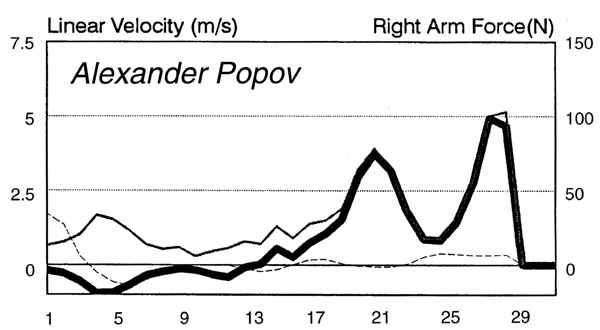
This graph shows how Alexander Popov effortlessly swims world record times. The heavy solid line shows the amount of propulsive force generated by his right arm. The dotted line below shows the velocity of his right hip as it rotates toward the surface. Popov rotates his hip 5/30ths of a second before his insweep, and again 5/30ths of a second before his outsweep. Despite having a small hip rotation, he is able to generate 75-100 Newtons of force. Increasing the speed of his hip rotation would enable him to increase his peek force to 150 Newtons and swim faster. Our goal in this elite camp is to do exactly this.
As you can see, Popov's stroke is 50% longer than most elite swimmers. This increase in stroke length comes from his early hip rotation. Popov rotates his hip 4/30ths of a second before his insweep, and again 4/30ths of a second before his outsweep. Amy Van Dyken was able, in one week, to advance the timing of her hip rotation 2/30ths before her insweep and outsweep. With an additional four weeks of training we hope to enable all the swimmers in our elite camp to advance the timing of their hip rotation to 4/30ths of a second before their insweep and outsweep.
Camp Content
We will teach elite swimmers to increase their stroke efficiency through frame-by-frame underwater stroke analysis, our exclusive drills, training aids and Microfiber, Stress and Tension Reduction.
Unlike most underwater videotape analysis, we measure stroke mechanics by degree every 1/30th of a second, and then we train swimmers to improve their mechanics, measuring their progress along the way.
Our drills have been developed over the past 15 years to increase the speed and advance the timing of hip rotation, the real source of power in freestyle and backstroke. Our drills also improve the speed and timing of hip undulation, the real source of power in butterfly. They also improve the timing, range and strength of the kick, the real source of power in the breaststroke.
Our training aids for this camp include this Somax POWERBELT, the only training aid that provides resistance to hip rotation, thereby increasing the strength and speed of this essential and critical movement.
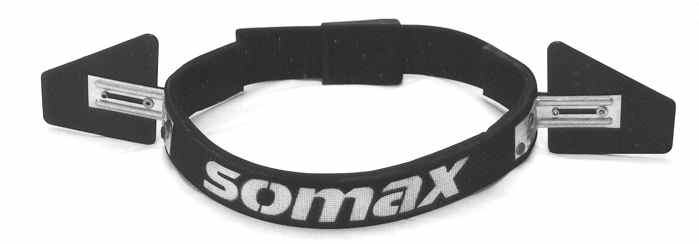
The POWERBELT (pat.pend.) is a pair of fins that strap onto the hips and provide resistance to hip rotation and undulation, the real source of power in swimming.
In addition to the POWERBELT we will introduce swimmers in this camp to exclusive new training aids developed by Somax.
Five sessions of Microfiber Reduction will improve flexibility by 50% or more in one or more of the ranges required for each stroke. Flexibility is critical to reducing drag, improving mechanics and increasing endurance by increasing flexibility in the chest and abdomen.
For further information on our training methods, please see Swimming, The Hidden Secrets of World Record Swimmers, Microfiber Reduction, Tension Reduction and Breathing.
Camp Location
This camp will be held at an indoor 50m pool near Tampa. Housing and food are available nearby.
Internet Stroke Analysis
To insure that participants in this camp continue to perform their stroke drills correctly, each swimmer will be provided with a year of bi-weekly Internet Stroke Analysis.
Once the swimmers return home, they will send Somax an underwater tape of their stroke from the sides and front every two weeks. Somax will download the tape onto this website. With a special password, the swimmers will be able to see their stroke analyzed frame-by-frame. Special drills will be recommended to correct any chronic problems.
Camp Follow-Up
Each swimmer will leave the camp with a 2500m laminated drill set to be performed a minimum of five times a week, a complete set of stretches and strength training exercises, and a Somax POWERBELT.
Camp Fees
Fees for instruction are $4,500 per week, for a total of $22,500 per swimmer. Fee for one year of bi-weekly Internet Stroke Analysis is $22,500.
Total camp fee is $45,000 per swimmer, due in full upon registration, and is non-refundable.
Camp fees do not include lodging, food, travel, or underwater video camera. Somax will provide swimmers with a list of potential housing within a short distance of the pool. We can also recommend an excellent underwater attachment for your camcorder, which will allow your stroke to be taped by someone standing on the deck.
Registration
The Elite Swim Camp is limited to a minimum of 6 and a maximum of 10 swimmers. National teams that have more than 10 swimmers to train, or want camps for additional strokes, should contact us.
To register and make inquiries, please contact Somax.
* To qualify for the guarantee, you must complete our 2500 yard drill set at least three times a week for a minimum of one year, send us each week underwater and above-water tapes of each drill set, and correct any mistakes we see. You also must not do any training regimen that we find reduces your flexibility, causes you to be over-trained, or degrades your stroke efficiency. If you do not improve any of your times in any stroke within one year of your camp, and you are still swimming competitively, you will get a complete refund of your camp fee. Injuries or illnesses that prevent or reduce training with our drills or competition void the guarantee.

